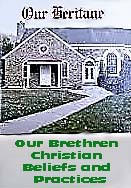MIXED
MULTITUDE AT THE CROSS
All
the writers in some way refer to the presence of the women. Matthew speaks of
the women from Galilee, and of these he names "Mary Magdalene, Mary the mother of James and Joses, and the
mother of the sons of Zebedee." (Matt.
27:46) Mark mentions these same three women, "Mary Magdalene, Mary the mother of James the less and of Joses,
and Salome," (Mark 15:40)
the wife of Zebedee, and therefore the mother of James and of John, the sons of
Zebedee. Luke gives no names, but he declares the fact of the presence of the
women in the words, "there followed
Him a great multitude of the people, and of women who bewailed and lamented
Him." (Luke 23:27) John
names the three referred to by Matthew and Mark, but adds another. It is he who
declares the presence of the mother of the Lord. There has been some difference
of opinion concerning John's account of the women present, which reads, "But there were standing by the Cross
of Jesus His mother, and His mother's sister, Mary the wife of Clopas, and Mary
Magdalene." (John 19:25)
Some interpret that verse as referring to three women. In that case it is
understood that His mother's sister was Mary the wife of Clopas. My own
conviction is that John mentions four women, that Mary of Clopas was not the
sister of Mary the mother of Jesus. To tabulate the statement of John, you
would write:
“His mother."
"His mother's sister."
"Mary the wife of Clopas."
"Mary Magdalene."
The
only difference between this account, and those of Matthew and Mark, is the
addition of the mention of Mary the mother of the Lord. In that case her sister
was Salome, the wife of Zebedee, and mother of James and John. It is
interesting to note in passing, the effect that this understanding of the
passage has upon certain facts in the Gospel history. The woman who came to the
Lord, and asked that her sons might sit, one on His right hand and one on His
left hand, was according to the flesh, related to Him, being His mother's
sister, and these men for whom the advantage was asked were His own cousins.
This gives some clue to what otherwise appears as a very strange request. If it
be granted that Salome was His mother's sister, we have at any rate some
explanation of her request in the fact that she suggested to Him that when He
came into the place of power He should find preferment for His family relations.
We
take it then for granted that four women are mentioned as being present at the
crucifixion of the Lord. In John we see two pairs, the unnamed women, the
mother of the Lord and her sister; and the two women who are named, Mary of
Clopas, and Mary Magdalene. As Luke records, there were many other women, but
these stand prominently out, as having been most closely associated with Him.
All
the evangelists speak of the presence of the soldiers, and of the two
malefactors crucified one on either side of Jesus. Matthew, Mark, and Luke draw
special attention to the centurion in charge of the carrying out of the
crucifixion, and they give some account of how he was impressed in the presence
of the Crucified. According to Matthew he said, "Truly this was a Son of God"; Matt. 27:54 (margin) according to Mark, “Truly this Man was a Son of God "; Mark 15:39 (margin) according to Luke, "Certainly this was a righteous Man." Luke 23:47 Let me at once say that
there is no contradiction between Matthew and Mark on the one hand, and Luke on
the other. It is almost certain that the centurion said both of these things.
It is certainly conceivable that as this man watched Jesus on the Cross, he
gave utterance to more than one sentence, and we believe therefore that while
Matthew and Mark record the statement which impressed them, Luke reported what
appealed to him, and was in perfect harmony with his whole scheme of teaching.
The accounts are rather complementary than contradictory.
The
presence of the chief priests is recorded by Matthew, Mark, and John, Luke
making no reference to them. Matthew, Mark, and Luke refer to the scribes,
elders, or rulers, comprising the Sanhedrim, while John ignores their presence.
Luke,
the burden of whose Gospel is that of the universality of the work and
relation of Jesus, declares the presence of great multitudes of the people.
John
alone tells us that the disciples were also there, and he only, moreover, refers
to the fact of his own presence, and this in order that he may record Christ's
committal of His mother to his care. Standing back and gazing out upon that MIXED
MULTITUDE, we notice the women, the soldiers, the criminals, the centurion, the
chief priests, the members of the Sanhedrim, the group of His own disciples,
and in addition to these, the vast multitudes of people from the whole
surrounding country. All sorts and conditions of men are gathered to the Cross,
REPRESENTATIVE CROWDS, the whole scene being a picture and a prophecy of how,
through all the centuries, every
sort and condition would be gathered to
the uplifted Cross of the Son of man.

No comments:
Post a Comment